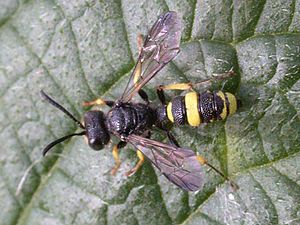Wasps
| Wasps | ||||||||||||
|---|---|---|---|---|---|---|---|---|---|---|---|---|

Bienenjagende node wasp ( Cerceris rybyensis ) |
||||||||||||
| Systematics | ||||||||||||
|
||||||||||||
| Scientific name | ||||||||||||
| Cerceris | ||||||||||||
| Latreille , 1802 |
The knot wasps ( Cerceris ) are a genus of digger wasps (Spheciformes) from the family Crabronidae . The genus is distributed worldwide and includes about 850 species. There are over 200 species in the Palearctic and 50 species in Europe.
features
The Cerceris species are medium to large in size and have characteristic constricted abdominal segments and a short, nodular first abdominal segment. Most of the digger wasps have a distinct yellow or whitish banding. The body surface varies in strength, but is clearly structured in a point-like manner. The second submarginal cell is stalked in the fore wing. The males have a yellow face and an equally colored forehead plate ( clypeus ), these areas are marked yellow in the females. Both the males and the females have a strongly developed pygidial field on the last abdominal segment.
Way of life and occurrence
The heat-loving animals mainly inhabit the warm and hot zones of the earth, only a few species are also found in the cooler north. The females create their nests in loose sand or in solid ground. They can often be found in large groups on roadsides or sunlit embankments. The enlarged pygidial field enables the females to move the excavated nest out into the open more easily. Mainly, however, the sand is transported backwards between the head and thorax. The excavation is heaped up to form a mound around the funnel-shaped nest entrance. However, depending on the type of Cerceris and the slope of the terrain, these hills may only be weakly recognizable or may be completely absent. If the nest is left, the female circles around the nest several times at increasing intervals for orientation, as in the Philanthus genus . The prey is brought into the nest in flight. The Central European species are beetles or smaller species of bees , depending on the Cerceris species .
Parasitoids of the genus are various flies and golden wasps , particularly of the genus Hedychrum .
Species (Europe)
- Cerceris abdominalis ( Fabricius , 1804)
- Cerceris albicolor Shestakov , 1918
- Cerceris albofasciata ( Rossi , 1790)
- Cerceris amathusia Beaumont , 1958
- Cerceris angustirostris Shestakov , 1918
- Cerceris arenaria ( Linnaeus , 1758)
- Cerceris bellona Mercet , 1914
- Cerceris bicincta Klug , 1835
- Cerceris boetica ( Pérez , 1913)
- Cerceris bracteata Eversmann , 1849
- Cerceris bucculata A. Costa , 1860
- Cerceris bupresticida Dufour , 1841
- Cerceris cheskesiana Giner Marí , 1945
- Cerceris circularis ( Fabricius , 1804)
- Cerceris concinna Brullé , 1839
- Cerceris dispar Dahlbom , 1845
- Cerceris dorsalis Eversmann , 1849
- Cerceris dusmeti Giner Marí , 1941
- Cerceris elegans Eversmann , 1849
- Cerceris eryngii Marquet , 1875
- Cerceris euryanthe cabbage , 1888
- Cerceris eversmanni Schulz , 1912
- Cerceris fimbriata ( Rossi , 1790)
- Cerceris flavicornis Brullé , 1833
- Cerceris flavilabris ( Fabricius , 1793)
- Cerceris flaviventris Vander Linden , 1829
- Cerceris fodiens Eversmann , 1849
- Cerceris hortivaga cabbage , 1880
- Cerceris ibericella Leclercq , 1979
- Cerceris impercepta Beaumont , 1950
- Cerceris interrupta ( tank , 1799)
- Cerceris lunata A. Costa , 1869
- Cerceris maculicrus Beaumont , 1967
- Cerceris media Klug , 1835
- Cerceris odontophora Schletterer , 1887
- Cerceris quadricincta ( carapace , 1799)
- Cerceris quadrifasciata ( carapace , 1799)
- Cerceris quinquefasciata ( Rossi , 1792)
- Cerceris rossica Shestakov , 1914
- Cerceris rubida ( Jurine , 1807)
- Cerceris ruficornis ( Fabricius , 1793)
- Cerceris rutila Spinola , 1839
- Cerceris rybyensis ( Linnaeus , 1771)
- Cerceris sabulosa ( carapace , 1799)
- Cerceris somotorensis Balthasar , 1956
- Cerceris specularis A. Costa , 1869
- Cerceris spinipectus F. Smith , 1856
- Cerceris stratiotes Schletterer , 1887
- Cerceris tenuivittata Dufour , 1849
- Cerceris tuberculata ( Villers , 1787)
photos
supporting documents
Individual evidence
- ↑ a b c d Manfred Blösch: The digger wasps in Germany: way of life, behavior, distribution . 1st edition. Goecke & Evers, 2000, ISBN 3-931374-26-2 , pp. 414 f .
- ↑ Cerceris. Fauna Europaea, accessed July 24, 2010 .
literature
- Manfred Blösch: The digger wasps in Germany: way of life, behavior, distribution . 1st edition. Goecke & Evers, 2000, ISBN 3-931374-26-2 .
